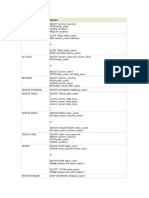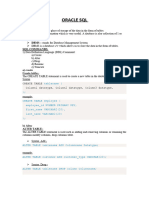Return Column Function
Uploaded by
mihaelahristeaReturn Column Function
Uploaded by
mihaelahristea6.7.3.
2 ReturnColumnDescription
The ReturnColumnDescription describes the columns, or combination of columns, to
return. It can be any of the following:
* (indicating all columns)
The name of a column
An expression involving column names, enclosed in brackets, along with strings
and string operators; for example, [PubID] & "- " & [Title]
(Note that, according to the syntax of the SELECT statement, ReturnColumnDescription
can be repeated as many times as desired.)
When two returned columns (from different tables) have the same name, it is necessary to
qualify the column names using the table names. For instance, to qualify the PubID
column name, we write BOOKS.PubID and PUBLISHERS.PubID. We can also write
BOOKS.* to indicate all columns of the BOOKS table.
Finally, each ReturnColumnDescription can end with:
[AS AliasName]
to give the return column a (new) name.
For example, the following statement:
SELECT DISTINCTROW
[ISBN] & " from " & [PubName] AS [ISBN from PubName]
FROM PUBLISHERS INNER JOIN BOOKS ON PUBLISHERS.PubID = BOOKS.PubID;
returns a single column result table ISBN-PUB, as shown in Table 6.10.
Table 6.10. The ISBN-PUB Table
ISBN from PubName
0-12-345678-9 from Small House
0-11-345678-9 from Small House
0-321-32132-1 from Small House
0-55-123456-9 from Small House
0-12-333433-3 from Big House
0-103-45678-9 from Big House
0-91-335678-7 from Big House
0-99-999999-9 from Big House
1-22-233700-0 from Big House
1-1111-1111-1 from Big House
0-91-045678-5 from Alpha Press
0-555-55555-9 from Alpha Press
0-99-777777-7 from Alpha Press
0-123-45678-0 from Alpha Press
Not only does the AS AliasName option allow us to name a "compound column," it also
allows us to rename duplicate column names without having to qualify the names.
You might also like
- Past Perfect Tense & Past Perfect Continuous0% (1)Past Perfect Tense & Past Perfect Continuous4 pages
- SQL: Just The Basics: Thursday, February 05, 2009No ratings yetSQL: Just The Basics: Thursday, February 05, 200910 pages
- Csegyan: Create Database Syntax: Show DatabasesNo ratings yetCsegyan: Create Database Syntax: Show Databases11 pages
- Book Publication Database (Sample Queries & Solutions Using Basic Commands)No ratings yetBook Publication Database (Sample Queries & Solutions Using Basic Commands)21 pages
- Unit-9 - CREATE A Table From Another TableNo ratings yetUnit-9 - CREATE A Table From Another Table13 pages
- SQL Data Manipulation: Prepared By: Dr. Vipul VekariyaNo ratings yetSQL Data Manipulation: Prepared By: Dr. Vipul Vekariya49 pages
- GBD - Sesion 06 Sentencia Create Table AsNo ratings yetGBD - Sesion 06 Sentencia Create Table As3 pages
- Difference Between SP and UDF Is Listed BelowNo ratings yetDifference Between SP and UDF Is Listed Below4 pages
- DDL Statements Alter Drop Truncate TableNo ratings yetDDL Statements Alter Drop Truncate Table24 pages
- SQL Commands - DDL Data Definition Language: Created by N Jayanthi PGT Rks CbeNo ratings yetSQL Commands - DDL Data Definition Language: Created by N Jayanthi PGT Rks Cbe22 pages
- Oracle: SQL Plus Tutorial: Logging On/OffNo ratings yetOracle: SQL Plus Tutorial: Logging On/Off8 pages
- SQL For Data Manipulation: Modifying Data in Tables and ViewsNo ratings yetSQL For Data Manipulation: Modifying Data in Tables and Views9 pages
- Java Programming Tutorial With Screen Shots & Many Code ExampleFrom EverandJava Programming Tutorial With Screen Shots & Many Code ExampleNo ratings yet
- Chi Kung - The Golden Elixir: 1. Definiti Si Aratati Semnificatia Notiunii de NectarNo ratings yetChi Kung - The Golden Elixir: 1. Definiti Si Aratati Semnificatia Notiunii de Nectar2 pages
- Asus ROG Zephyrus S GX531: 1.what Are The Main Characteristics?No ratings yetAsus ROG Zephyrus S GX531: 1.what Are The Main Characteristics?3 pages
- Pretul Unitar A) Material B) Manopera C) Utilaj D) Transport Total: A+b+c+dNo ratings yetPretul Unitar A) Material B) Manopera C) Utilaj D) Transport Total: A+b+c+d2 pages
- Peace: Gerard Manley Hopkins, 1844 - 1889No ratings yetPeace: Gerard Manley Hopkins, 1844 - 18891 page























































































